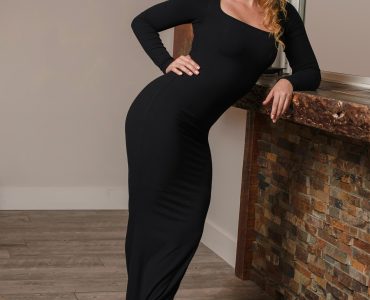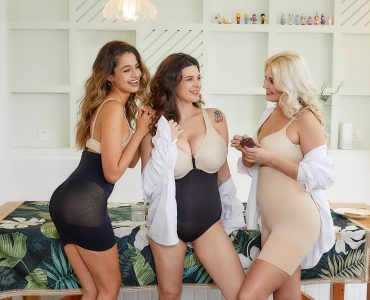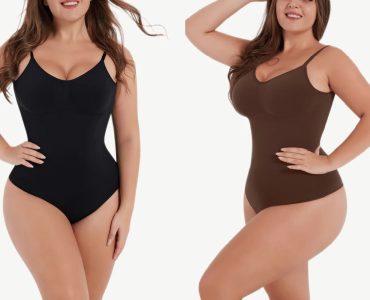I’ll be honest with you—being in my 50s with a proudly XXL body size, getting dressed can sometimes feel like a battle. You know that moment when you pull out a dress you love, only to realize it betrays you by showing every little bump—yes, including that one stubborn belly roll and the “asses panties” effect at the back? Been there.
And don’t get me started on family events where you have to look polished, but your shapewear feels like a medieval torture device.
But lately, I’ve been exploring something new—sustainable shapewear. Not just any “suck-it-in” garment, but pieces designed to shape and support while being kinder to the planet. And honestly? I wish I had discovered this earlier.
So, let me take you through my personal journey (with some humor sprinkled in) into the world of eco-friendly shapewear—why it matters, why it feels better, and how it might just change the way you think about fashion.
What Is Sustainable Shapewear?
At first, I thought “sustainable shapewear” was just another fancy marketing buzzword. But no—it’s actually a whole movement. Unlike regular shapewear that’s usually made from synthetic fabrics and cheap materials, sustainable shapewear is created with eco-friendly fabrics, ethical production, and a focus on durability.
Think of it as shapewear that doesn’t just shape you—it also shapes a better world.
The difference? Regular shapewear often traps heat, irritates the skin, and doesn’t last long. Sustainable shapewear, on the other hand, is breathable, softer, and built to last. And yes, it still smooths those bumps that make us feel less confident in that little black dress.
Eco-Friendly Fabrics in Modern Shapewear

When I first read “bamboo fabric shapewear,” I thought, Am I supposed to be a panda now? But hear me out—bamboo, organic cotton, and recycled nylon are leading the way in eco shapewear innovation.
- Recycled Nylon: Imagine old fishing nets and fabric scraps being reborn into something that hugs your curves beautifully. That’s recycled nylon.
- Organic Cotton: Softer, more breathable, and chemical-free—so no itchy red marks after a long day.
- Bamboo Fabric: Naturally antibacterial and moisture-wicking, perfect for humid climates (like mine).
It feels good knowing that instead of contributing to landfill waste, I’m literally wearing fabrics that help reduce it.
Why Sustainable Shapewear Is Better for Skin and Body
I’ll say it—after 40, my skin became fussier than a teenager. Regular shapewear would sometimes leave me with rashes or that awful “suffocated” feeling. But with sustainable shapewear, the difference is night and day.
- Breathable: No more sweating like I just ran a marathon when all I did was attend a wedding buffet.
- Gentle on Skin: No harsh chemicals, which means no irritation or weird smells.
- Better Circulation: The stretch is supportive but not suffocating.
Comfort is everything at this age. I want support, yes, but I also want to breathe while eating that slice of cheesecake without worrying my shapewear will explode.
Fashion Trends 2025: The Rise of Eco-Friendly Shapewear
Here’s the truth: sustainability is no longer optional in fashion. From luxury designers to everyday brands, the trend is shifting. In 2025, eco-friendly shapewear is booming because people want to feel good and do good.
It’s not just me being “auntie conscious.” Younger generations—Gen Z and Millennials—are also pushing this trend. And guess what? Brands are listening. The result: sustainable shapewear collections that are stylish, supportive, and guilt-free.

Shapewear vs. Fast Fashion: Which Future Do We Choose?
Fast fashion shapewear may look tempting—five pairs for the price of one—but let me tell you, they don’t last. I’ve had seams split mid-event, straps digging in, and that one time when I felt like a sausage about to burst.
Sustainable shapewear might cost more upfront, but here’s the difference:
- Fast Fashion Shapewear: Cheap, short lifespan, harmful to the environment.
- Sustainable Shapewear: Durable, high-quality fabrics, eco-conscious.
It’s like choosing between buying five cheap umbrellas that break after one rainstorm versus one sturdy umbrella that lasts for years.
How Shapewear Brands Reduce Carbon Footprint
You’d be surprised at how creative eco-friendly brands have become:
- Using recycled packaging instead of plastic.
- Partnering with carbon-neutral shipping.
- Choosing renewable energy in production.
When I read that some brands even plant trees to offset emissions, I thought, Finally—guilt-free shopping!
Shapellx and Sustainability: Real Deal or Marketing Trick?
Let’s be honest—sometimes brands throw around the word “sustainable” without much action. But I’ve been following Shapellx, and I like what I see. Their focus isn’t just on shapewear sale events or hyped-up marketing—it’s on creating collections with eco-conscious fabrics and long-lasting design.
Is it perfect? Not yet. But compared to the sea of brands that don’t even bother, Shapellx feels like they’re moving in the right direction.
Eco-Friendly Shapewear for Women 40+: Comfort and Support First
At my age, I’m not looking for shapewear that turns me into a 20-year-old Barbie. I want something that supports my back, smooths the tummy, and lifts without suffocating. Sustainable shapewear checks all those boxes.
Plus, it gives me peace of mind knowing I’m wearing something good for my body and the planet. Double win.
Price vs. Value: Is Sustainable Shapewear Worth It?
Let’s be real—yes, it’s pricier. But would you rather buy five pairs of asses panties that lose elasticity in two washes, or one pair of high-quality sustainable shapewear that lasts for years?
I did the math, and honestly, buying fewer but better pieces saves money in the long run. Plus, less waste in my closet.
How to Care for Sustainable Shapewear
If you want your eco-friendly shapewear to last longer:
- Hand wash with mild detergent.
- Air dry—no harsh dryers.
- Avoid fabric softeners, which break down elastic.
Think of it as self-care for your clothes. Treat them well, and they’ll support you (literally).
Body Positivity and Sustainable Shapewear
Some people argue that shapewear goes against body positivity. But for me, it’s about choice. I love my curves, but I also love feeling smoother in a bodycon dress. Sustainable shapewear supports self-love while letting us present our best selves without harming the planet.
The Psychological Boost: Looking Good, Doing Good
I swear, wearing eco-friendly shapewear gives me an extra confidence boost. It’s not just about looking good—it’s about feeling good knowing I’m making a small difference. Fashion should be about joy, not guilt.
Eco-Fashion Collaborations: Shapewear Meets High Fashion
Big-name designers are already collaborating with eco-conscious shapewear brands. Imagine a runway dress paired with bamboo-fiber shapewear underneath. Chic, sustainable, and empowering.
How Consumers Can Choose Wisely
Here’s my quick checklist when shopping for sustainable shapewear:
- Look for certified eco-friendly fabrics.
- Check if the brand shares its sustainability practices openly.
- Support brands that prioritize durability over fast sales.
Everyday Wear vs. Special Events
For daily wear, I go for lighter, breathable, sustainable shapewear—perfect under jeans or flowy dresses. For weddings or formal events, I bring out the stronger tummy-control bodysuit. Both eco-friendly, both supportive.
Final Thoughts: Shaping the Future, Sustainably
Sustainable shapewear isn’t just about smoothing belly rolls or lifting the backside. It’s about aligning our fashion choices with our values—comfort, confidence, and care for the planet.
And if, like me, you’re in the XXL club and sometimes feel self-conscious in that gorgeous dress—remember this: shapewear should support you, not punish you. And when it’s sustainable, it supports the Earth, too.
So yes, the next time there’s a shapewear sale, I’m hunting for sustainable options first. Because let’s be real—life’s too short to feel guilty about looking fabulous.



